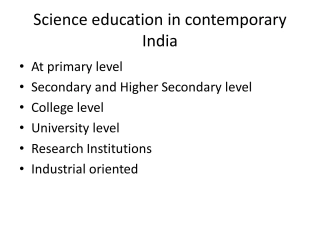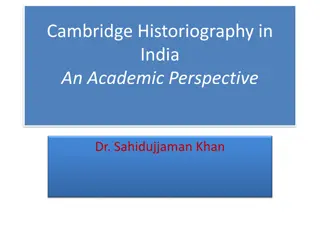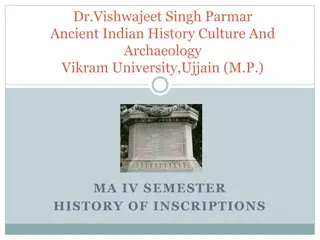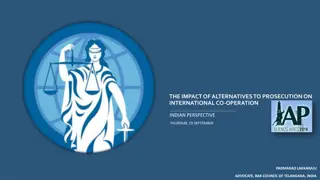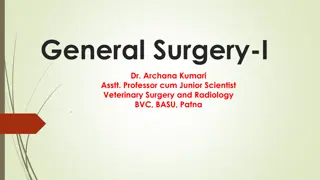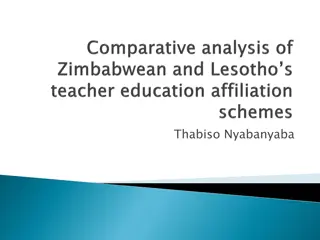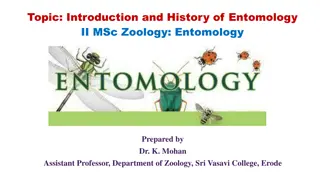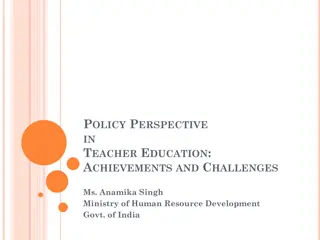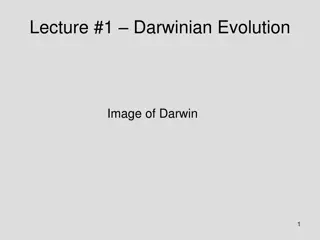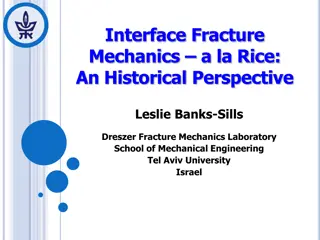Evolution of Science Education in India: A Historical Perspective
The evolution of science education in India has seen significant changes over the years, starting from the post-independence era with a commitment to promoting science and technology for national development. Policies like the Scientific Policy Resolution, formation of the Education Commission, National Education Policy, and the National Curriculum Framework have shaped the landscape of science education in the country. Efforts have been made to integrate science and technology in the curriculum, train teachers, and nurture talent among students. The focus has shifted towards a more holistic approach to teaching all branches of science in an integrated manner.
Download Presentation

Please find below an Image/Link to download the presentation.
The content on the website is provided AS IS for your information and personal use only. It may not be sold, licensed, or shared on other websites without obtaining consent from the author. Download presentation by click this link. If you encounter any issues during the download, it is possible that the publisher has removed the file from their server.
E N D
Presentation Transcript
Science Education in India A Changing Scenario Sudhakar Agarkar VPM s Academy of International Education and Research Thane, Maharashtra State, India
S & T for National Development Soon after independence India committed itself to the task of promoting science and technology as one of the most important elements of national developments. The first Scientific Policy Resolution was drafted in 1958. It was revised in 1983, in 2003 and recently in 2013 taking into account the feedback and the needs of the countrymen. Deliberate efforts were made to prepare curriculum for schools and implement it effectively. A variety of schemes were initiated to identify and nurture talent among school students. At the same time attempts were made to develop scientific and technological literacy among the masses. Science Education in India Sudhakar Agarkar AIER Thane 11/13/2024 2
Education Commission Government of India constituted an Education Commission in 1964. The commission considered school education in its entirety and gave some concrete suggestions in its report entitled Education and National Development An important recommendation made by the commission was to make the teaching of science an mathematics compulsory upto the school leaving state.. Following the recommendation of the Education Commission three disciplines of science namely Physics, Chemistry and Biology were included in school curriculum from grade 9. Science Education in India Sudhakar Agarkar AIER Thane 11/13/2024 3
National Education Policy School Education was relooked by the experts from different fields in 1984. It resulted into National Education Policy (NPE). NPE suggested that all branches of science should be taught in an integrated manner instead of compartmentalised disciplines like Physics, Chemistry and Biology. Accordingly, the National Council of Educational Research and Training (NCERT) an apex advisory body undertook the task of preparing integrated Science Text Books. I was directly involved in this revision. Science Education in India Sudhakar Agarkar AIER Thane 11/13/2024 4
National Curriculum Framework 2000 The school education in the country was reviewed at the millennium year. It suggested that science alone is not enough. It should be taught along with its technological ramifications. Thus the curriculum called Science and Technology came into existence, NCERT prepared model text books and the states following its guidelines of prepared text books in local languages. A big task of teacher training was undertaken to train the teachers to handle newly prepared syllabus of science and technology. Science Education in India Sudhakar Agarkar AIER Thane 11/13/2024 5
National Curriculum Framework 2005 Within just five years the education system in the country was once again relooked at. It resulted into the National Curriculum Framework 2005. The special feature of the policy was the focus on indigenous science and technology. It emphasised that the a long tradition of science and technology existing in India must be highlighted in school science education. Once again NCERT took the lead in preparing new text books and the Bureau of text book production in each state modified their curricula accordingly. Science Education in India Sudhakar Agarkar AIER Thane 11/13/2024 6
Identification and Nurturance of Talent Apart from formal teaching of science in schools, an attempt is being made to identify and nurture science talent among school students. In tis context a variety of programmes have been undertaken by the department of education in collaboration with the debarment of science and technology. They can listed as National Science Talent Examination Kishore Vaigyanic Protsahan Yojana International Olympiad National Children s Science Congress Inspire Award Ignite Scheme Science Education in India Sudhakar Agarkar AIER Thane 11/13/2024 7
National Talent Search Scheme NCERT launched a scheme called National Science Talent Search Scheme (NSTSS) in 1963. In the initial period the scholarships were awarded to students for pursuing education only in basic sciences up to doctoral level. NSTS scheme underwent a change in 1976 and was extended to include social sciences along with engineering and medicine. It was renamed as National Talent Search Scheme (NTSS). Apart from financial assistance summer camps and seminars are also arranged for the students who are selected through this scheme. Over the last four decades (1963-2015) a large number of students are benefited by this scheme. Many of them contributed to country s self reliance plan. Science Education in India Sudhakar Agarkar AIER Thane 11/13/2024 8
KVPY A scheme named Kishore Vaigyanik Protsahan Yojana (KVPY) was launched in 1999 to encourage scientific creatively among post school students. Funded by the Department of Science and Technology (DST), Government of India, the scheme is meant to attract highly motivated students for pursuing basic science courses and career in research. Managed by the Indian Institute of Science (IISC), Bangalore the candidates are selected through written test, project work and personal interview. There are three streams: Stream SA is for students enrolled in grade XI, stream SX is for students enrolled in grade XII and stream SB is for those who have registered for the graduate programme (B.Sc.). The selected candidates are given generous scholarship and contingency grant to pursue higher studies in science (www.kvpy.org.in). KYPY scholars are directly admitted to newly established Indian Institute of Science Education and Research (IISER). Science Education in India Sudhakar Agarkar AIER Thane 11/13/2024 9
International Olympiads Government of India entrusted the responsibility of selecting teams for International Science Olympiads to the Homi Bhabha Centre for Science Education (HBCSE), TIFR, Mumbai. Since 1998, HBCSE has been identifying and preparing students for international Olympiad competitions in Physics, Chemistry, Biology, Astronomy and Junior Science. A large number of students from secondary and higher secondary schools appear for national level competitive examinations. Training cum selection camp is held top 50 students at HBCSE. All the expenses of the international contest are borne by Government of India. The performance of Indian teams in international competitions has been quite good. India also hosted a International events like International Biology Olympiad, International Astronomy Olympiad, International Junior Science Olympiad, etc. (www.olympiads.hbcse.tifr.res.in). Science Education in India Sudhakar Agarkar AIER Thane 11/13/2024 10
JNNSE Organization of school level science exhibitions was initiated in 70s to provide opportunities to innovative teachers and students to display their talent. After a slow start the activity has spread length and breadth in the entire country. Named as Jawaharlal Nehru National Science Exhibitions it is organised by education department. Starting from taluka level (small administrative block of a district) these exhibitions are arranged at district, state, national as well as at international levels sequentially. Through this activity a large number of innovative ideas from school students and teachers have surfaced in the last four decades. Science Education in India Sudhakar Agarkar AIER Thane 11/13/2024 11
National Childrens Science Congress National Council of Science and Technology Communication (NCSTC), Department of Science and Technology, Government of India has initiated a Children s Science Movement in 1993. NCSTC arranges National Children's Science Congress (NCSC) annually for the children between 10 to 17 years from all over the country to provide a forum to the young scientists to pursue their natural curiosity and to quench their thirst for creativity by experimenting on open-ended problems (www.ncstc.dst.gov.in). Over the last 20 years this activity has taken a good shape involving a large number of teachers and students from both urban as well as rural schools. Jidnyasa Trust, Thane encourages schools to participate in this contest. Science Education in India Sudhakar Agarkar AIER Thane 11/13/2024 12
Inspire Award A new scheme has been launched in 2010 by the Department of Science and Technology to trap the science talent existing in young students. The scheme popularly known as INSPIRE (Innovation in Science Pursuit for Inspired Research) encourages school and college students to come out with innovative ideas in science. The scheme has three components: SEATS (Scheme for Early Attraction of Talent), SHE (Scholarships for Higher Education), and AORC (Assured Opportunity for Research Career). SEATS is for students of age between 10 and 15 years, SHE is for the students with a little higher age group (17 to 22 years) while AORC is for the students pursuing doctoral studies or for those who have entered into profession recently (www.inspire-dst.gov.in/award.html). Science Education in India Sudhakar Agarkar AIER Thane 11/13/2024 13
Ignite Scheme The National Innovation Foundation (NIF), established as an autonomous unit of the of DST, Government of India in March 2000 came out with a scheme entitled Ignite to provide institutional support to grass-root innovators and outstanding knowledge holders in an un-organized sectors. It attempts to identify hidden talent from among the community through submission of write ups. Any child irrespective of his/her educational qualification can submit the entry for this competition. The best entries are recognised and supported. In a short time the scheme has reaped good fruits. It could collect about 20,000 new ideas and file about 650 patents of which 40 have been granted (www.nif.org.in/ignite). Science Education in India Sudhakar Agarkar AIER Thane 11/13/2024 14
Scientific and Technological Literacy Apart from teaching science formally in school set up an attempt is made to spread scientific and technological literacy among the masses through a variety of activities. Some of these activities are initiated by the department of education of the central and state governments. The department of Science and Technology has set National Council of Science and Technology Communication (NCSTC) to undertake this work all over the country. Science Education in India Sudhakar Agarkar AIER Thane 11/13/2024 15
Voluntary Efforts in STL Associations of Science Teachers undertake science popularization activities in their vicinity for the benefit of common citizens. A large number of voluntary agencies existing in the country also undertake the task of spreading scientific and technological literacy in regional languages. In the state of Maharashtra we have the Marathi Vidnyan Parishad that publishes a journal, arranges lecture demonstrations and provide answers to children s questions in Marathi (the language used in the state of Maharashtra). The 51st Annual Convention of this organization is presently going on. Science Education in India Sudhakar Agarkar AIER Thane 11/13/2024 16
Higher Education in Science The Government of India, based on the recommendation of Scientific Advisory Council to the Prime Minister, initiated the establishment of Indian Institutes of Science Education and Research (IISER) in 2006. Presently there are seven IISERs located at Pune (Maharashtra), Mohali (Punjab), Bhopal (MP), Kolkata (WB), Tirupati (AP), Trivendrum (Kerala) and Behrampur (Orissa). In less than a decade these institutions have made their names in science teaching and research in basic sciences. Science Education in India Sudhakar Agarkar AIER Thane 11/13/2024 17
Research in Science Education A systematic research has been initiated to improve the teaching of science in Indian schools. Education colleges spread across the country undertake research in selected areas of science education. NCERT with its wings in north, south, east and west conducts and encourages research in science education. Research institutes like the Tata institute of Fundamental Research established dedicated centre named the Homi Bhabha Centre for Science Education to conduct systematic research in science and mathematics education (1974). Science Education in India Sudhakar Agarkar AIER Thane 11/13/2024 18
Development of Methods an Materials Many institutions are engaged in developing methods and preparing materials to improve the teaching of science in schools. For example, a kit of apparatus was designed to perform science experiments at low cost where laboratory does not exist. Use of technology in school education is yet another area of work. India launched a dedicated satellite named EDUSAT in 2005 to establish a two way audio/video link. Open Educational Resources are prepared and made available to students, their teachers and parents free of cost. Attempt is being made to use modern technology like Augmented reality to enable A3 (Anywhere, Anytime and by Anyone) learning of science. Science Education in India Sudhakar Agarkar AIER Thane 11/13/2024 19
Industries and Research Organizations Along with the improvement of science education the government of India focussed its attention in industrial growth where the newly trained persons could get employment. As it stands today the industrial status of the country is quite high. Equal attention has been given to the establishment of research institutions. These organizations provide an opportunity to the young lads to undertake innovative work within the country itself. The work carried our indigenously in the country has resulted into successful Atomic Energy programme, Space programme, Green Revolutions and progress in Information Technology. Science Education in India Sudhakar Agarkar AIER Thane 11/13/2024 20
Thank you Any Question? sagarkar@vpmthane.org

 undefined
undefined





